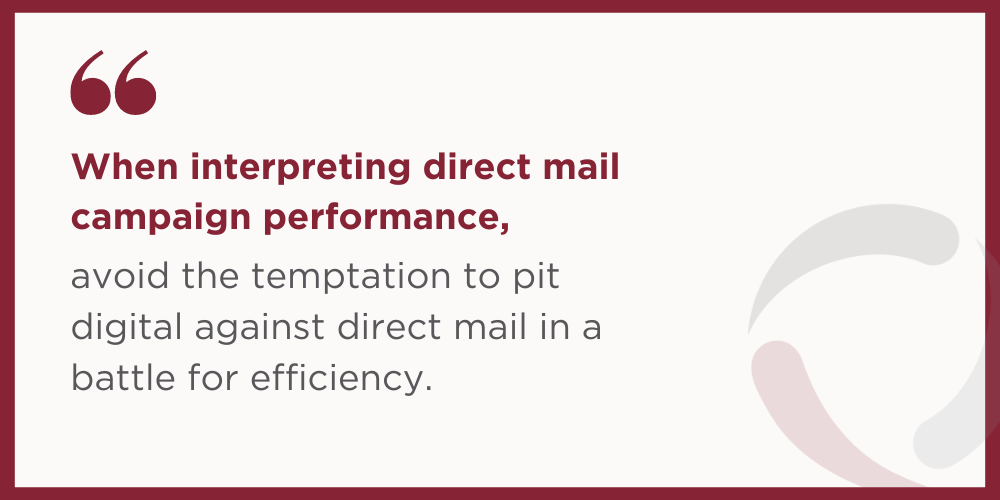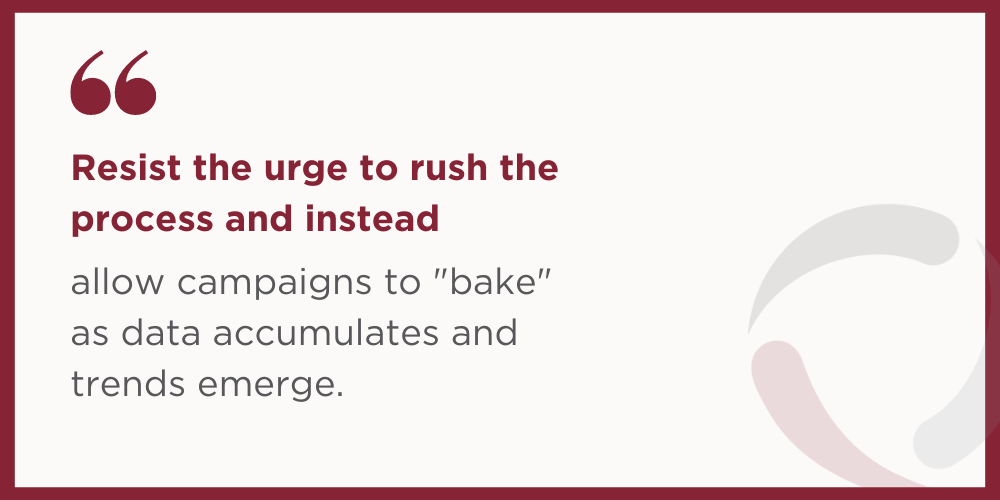Direct Mail Performance and KPIs: Six Things You Should Know

When asked about the top advantages of direct mail, 31% of marketers reported that it’s easy to track attribution and performance. Yet, despite this perceived advantage, many marketers still grapple with questions and confusion surrounding direct mail performance tracking.
This article will explore six insights and strategies for analyzing, optimizing, and elevating your direct mail campaign performance this year and beyond.
|
Prefer to listen? Check out our podcast The Direct Effect: Direct Mail Performance and KPIs: Six Things You Should Know |
1. Each brand is different, and so are its KPIs
Marketing analytics influence just over half (53%) of marketing decisions. The mail channel is no exception, where key performance indicators (KPIs) serve as customized benchmarks tailored to attain brand-specific objectives and desired outcomes.
Common direct mail KPIs include sales rate, leads, response rate, cost per acquisition (CPA), customer acquisition cost (CAC), cost per lead (CPL), revenue, return on investment (ROI), return on ad spend (ROAS), and lifetime customer value (LTV).
It’s important to understand that each brand has a unique ecosystem influenced by industry nuances, economic fluctuations, and evolving consumer preferences. Forcing your mailing into a one-size-fits-all KPI is a costly mistake that will eventually kill a mail program.
Here are some examples of how different brands may prioritize direct mail KPIs and how these metrics affect your bottom line:
- A home security company may aim to increase sales and mailing volumes.
- A fintech brand may look for a lift in sales rate overall.
- A travel brand targeting frequent travelers may prioritize lifetime customer value.
- A home warranty provider testing direct mail as an acquisition tool may want to increase acquisition numbers to meet their growth goals.
Your brand’s priorities in terms of KPIs may even shift from one campaign to the next. In one campaign, you might prioritize sales volume to drive immediate revenue. In the next, the focus might shift to customer acquisition costs to expand your customer base. This adaptability underscores the importance of agility and flexibility in setting and achieving KPIs.

2. Alignment is key
Effective communication and alignment within your company are vital to identifying successful direct mail campaign analytics. This maximizes your direct mail budget and enhances program performance. The last thing you want is to fall victim to “KPI overload.” With too many KPIs to track, you can waste your time and energy on irrelevant metrics.
For instance, your company’s marketing team may focus more on increasing sales and response rates to generate immediate revenue and measure customer engagement. However, top-level management may prioritize ROI and LTV to determine the program’s long-term profitability and sustainability.
To avoid this, prioritize building a collaborative environment where all stakeholders are aligned on brand goals and top marketing objectives. With clarity and cohesion, you can streamline the planning process and empower your direct mail partner to deliver tailored solutions that resonate with your target audience.
3. It shouldn’t be “direct mail versus digital”
When interpreting direct mail campaign performance, avoid the temptation to pit digital against direct mail in a battle for efficiency. Such comparisons overlook the complementary nature of these channels, each offering unique advantages in reaching and engaging consumers.
Instead of viewing them in isolation, embrace the synergy between digital and direct mail, leveraging the strengths of each to amplify your marketing efforts and drive meaningful results. After all, you’re not comparing apples to apples, and nine out of ten marketers report that integration positively impacts campaign performance.
With SeQuel Surround, the emphasis is on collaboration rather than competition between digital and direct mail channels. Through advanced targeting, personalized messaging, and coordinated campaign management, SeQuel Surround ensures that the two channels work in tandem to deliver maximum impact. This not only optimizes marketing spend, but also enhances overall campaign effectiveness by an average of 30%.

4. Do not underestimate the power of a matchback
Digital marketing channels offer robust analytics and tracking capabilities, but they often struggle to tie individual sales to specific campaigns, as tracking may rely on unreliable cookies or pixels. On the other hand, direct mail provides a tangible connection between marketing efforts and consumer actions, allowing you to track campaign performance accurately. With this channel, you can validate campaign results from awareness to action across channels via matchback and holdout strategies.
Matchbacks are essential when determining campaign performance and mail’s impact, as only a third of direct mail responses come through directly attributable elements like URLs, TFNs, or promo codes. Direct mail holdouts act as a control group to calculate incremental sales rate and lift for direct mail.
Suppose you’re promoting a new product line. In that case, a matchback analysis can help identify which recipients made purchases after receiving the mailer. This quantifies the campaign’s impact on sales and reveals valuable demographic and behavioral patterns among responsive customers. With this information, you can refine future mailings, retarget previous audiences, and adjust your messaging.
5. Avoid rushing results
In an era of instant gratification, patience is often overlooked. Yet, in direct mail, it is not merely a virtue but a strategic imperative. Results take time to materialize, and insights require diligent analysis to uncover.
Resist the urge to rush the process and instead allow campaigns to “bake” as data accumulates and trends emerge. Through careful observation and strategic refinement, you can optimize direct mail programs, inching closer to your goals with each iteration.
Initial campaign results do not always look impressive in the period following the mailing. However, with time, you may observe a gradual increase in conversions by giving customers enough time to act on the offer. You can then analyze response data and customer feedback, identifying the most responsive audience segments, compelling offer variations, and so on.

6. There are benefits to working with an agency
Direct mail can be a complex field to navigate, one that requires expertise, experience, and a deep understanding of industry best practices. This is where partnering with a seasoned direct mail agency can be incredibly valuable.
The best direct response agencies offer much more than just execution – they can provide strategic guidance, actionable insights, and a wealth of resources to help brands succeed. From interpreting performance data to conducting statistical validity calculations, agencies play a pivotal role in maximizing the impact and ROI of direct mail campaigns.
At SeQuel Response, our work doesn’t stop when your packages reach the mailbox. We understand that the real magic happens in the post-campaign analysis. That’s why our in-depth analytics reporting provides actionable insights that allow you to make smarter decisions to optimize your direct mail performance faster. Whether identifying the most responsive audience segments, fine-tuning messaging for maximum impact, or refining targeting criteria based on real-time data, our dedicated team is committed to driving results and delivering exceptional value to your brand.
————
By prioritizing these six key insights, you’ll have the necessary tools to analyze and optimize your direct mail performance. With dedication and perseverance, success in direct mail is not just achievable – it’s inevitable.
Read this Direct Mail Attribution Guide to learn more about tracking direct mail performance and building a direct mail attribution strategy, and contact a SeQuel Strategist to start a conversation today.

